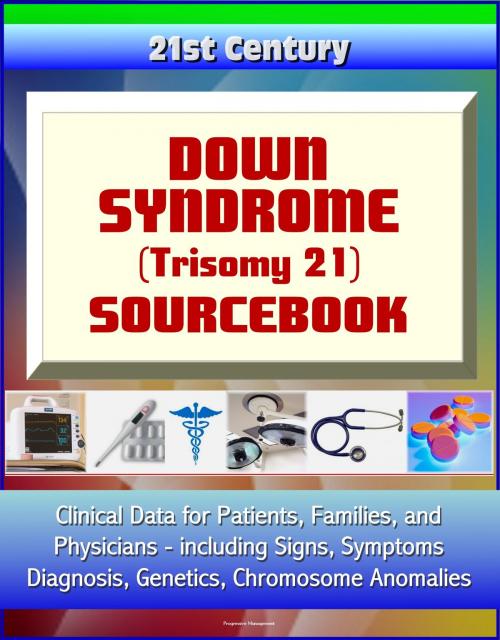21st Century Down Syndrome (Trisomy 21) Sourcebook: Clinical Data for Patients, Families, and Physicians, including Signs, Symptoms, Diagnosis, Genetics, Chromosome Anomalies
Nonfiction, Health & Well Being, Medical, Ailments & Diseases, Diseases| Author: | Progressive Management | ISBN: | 9781301792429 |
| Publisher: | Progressive Management | Publication: | November 10, 2012 |
| Imprint: | Smashwords Edition | Language: | English |
| Author: | Progressive Management |
| ISBN: | 9781301792429 |
| Publisher: | Progressive Management |
| Publication: | November 10, 2012 |
| Imprint: | Smashwords Edition |
| Language: | English |
This comprehensive ebook provides authoritative information and practical advice from the nation's health experts about Down Syndrome, also known as Down's Syndrome or trisomy 21.
Starting with the basics, and advancing to detailed patient-oriented and physician-quality information, the 21st Century Sourcebook series gives empowered patients, families, caregivers, nurses, and physicians the information they need to understand this disease. There is extensive coverage of symptoms, diagnosis, medical testing, clinical research, drugs and potential treatments.
Chapter 1: National Institute of Child Health and Human Development Information * Chapter 2: NHGRI - National Human Genome Research Institute Information * Chapter 3: Office of Rare Diseases Research of the National Center for Advancing Translational Sciences / Genetic and Rare Diseases Information Center Information * Chapter 4: Genetics Home Reference Information (GHR NLM) * Chapter 5: Centers for Disease Control and Prevention (CDC) Information * Chapter 6: National Institutes of Health Research Portfolio Online Reporting Tools (RePORT) - Down Syndrome Studies * Chapter 7: Clinical Trials * Section B: Guide to Leading Medical Websites; Internet Resources For Medical And Health Information
This edition includes our exclusive Guide to Leading Medical Websites with updated links to 81 of the best sites for medical information, which let you quickly check for updates from the government and the best commercial portals, news sites, reference/textbook/non-commercial portals, and health organizations.
Down syndrome is a set of mental and physical symptoms that result from having an extra copy of Chromosome 21. Normally, a fertilized egg has 23 pairs of chromosomes. In most people with Down syndrome, there is an extra copy of Chromosome 21 (also called trisomy 21 because there are three copies of this chromosome instead of two), which changes the body’s and brain’s normal development. Even though people with Down syndrome may have some physical and mental features in common, symptoms of Down syndrome can range from mild to severe. Usually, mental development and physical development are slower in people with Down syndrome than in those without the condition. Intellectual and Developmental Disabilities (IDDs) is a disability that causes limits on intellectual abilities and adaptive behaviors (conceptual, social, and practical skills people use to function in everyday lives). Most people with Down syndrome have IQs that fall in the mild to moderate range of IDDs. They may have delayed language development and slow motor development.
The chance of having a baby with Down syndrome increases as a woman gets older—from about 1 in 1,250 for a woman who gets pregnant at age 25, to about 1 in 100 for a woman who gets pregnant at age 40. But, most babies with Down syndrome are born to women under age 35 because more younger women have babies. Because the chances of having a baby with Down syndrome increase with the age of the mother, many health care providers recommend that women over age 35 have prenatal testing for the condition. Testing the baby before it is born to see if he or she is likely to have Down syndrome allows parents and families to prepare for the baby’s special needs. Parents who have already had a baby with Down syndrome or who have abnormalities in their own chromosome 21 are also at higher risk for having a baby with Down Syndrome. Once the baby is born, a blood test can confirm whether the baby has Down syndrome.
This comprehensive ebook provides authoritative information and practical advice from the nation's health experts about Down Syndrome, also known as Down's Syndrome or trisomy 21.
Starting with the basics, and advancing to detailed patient-oriented and physician-quality information, the 21st Century Sourcebook series gives empowered patients, families, caregivers, nurses, and physicians the information they need to understand this disease. There is extensive coverage of symptoms, diagnosis, medical testing, clinical research, drugs and potential treatments.
Chapter 1: National Institute of Child Health and Human Development Information * Chapter 2: NHGRI - National Human Genome Research Institute Information * Chapter 3: Office of Rare Diseases Research of the National Center for Advancing Translational Sciences / Genetic and Rare Diseases Information Center Information * Chapter 4: Genetics Home Reference Information (GHR NLM) * Chapter 5: Centers for Disease Control and Prevention (CDC) Information * Chapter 6: National Institutes of Health Research Portfolio Online Reporting Tools (RePORT) - Down Syndrome Studies * Chapter 7: Clinical Trials * Section B: Guide to Leading Medical Websites; Internet Resources For Medical And Health Information
This edition includes our exclusive Guide to Leading Medical Websites with updated links to 81 of the best sites for medical information, which let you quickly check for updates from the government and the best commercial portals, news sites, reference/textbook/non-commercial portals, and health organizations.
Down syndrome is a set of mental and physical symptoms that result from having an extra copy of Chromosome 21. Normally, a fertilized egg has 23 pairs of chromosomes. In most people with Down syndrome, there is an extra copy of Chromosome 21 (also called trisomy 21 because there are three copies of this chromosome instead of two), which changes the body’s and brain’s normal development. Even though people with Down syndrome may have some physical and mental features in common, symptoms of Down syndrome can range from mild to severe. Usually, mental development and physical development are slower in people with Down syndrome than in those without the condition. Intellectual and Developmental Disabilities (IDDs) is a disability that causes limits on intellectual abilities and adaptive behaviors (conceptual, social, and practical skills people use to function in everyday lives). Most people with Down syndrome have IQs that fall in the mild to moderate range of IDDs. They may have delayed language development and slow motor development.
The chance of having a baby with Down syndrome increases as a woman gets older—from about 1 in 1,250 for a woman who gets pregnant at age 25, to about 1 in 100 for a woman who gets pregnant at age 40. But, most babies with Down syndrome are born to women under age 35 because more younger women have babies. Because the chances of having a baby with Down syndrome increase with the age of the mother, many health care providers recommend that women over age 35 have prenatal testing for the condition. Testing the baby before it is born to see if he or she is likely to have Down syndrome allows parents and families to prepare for the baby’s special needs. Parents who have already had a baby with Down syndrome or who have abnormalities in their own chromosome 21 are also at higher risk for having a baby with Down Syndrome. Once the baby is born, a blood test can confirm whether the baby has Down syndrome.















